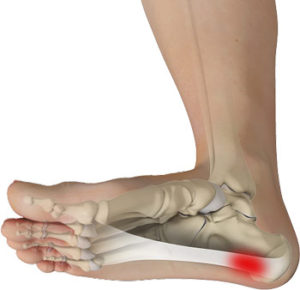Heel pain can be extremely frustrating for a runner. Symptoms typically present on rising in the morning, or after sitting for periods of time. Often sore at the start of a run but can improve when warm. There is the fear that running can worsen the condition. A common question I get asked is ‘Should I stop running?‘

For most runners – the short answer is no. Maintaining some running while rehabilitating the injury will likely lead to better long term outcomes.
Lets assume you are not getting pain on walking and we have ruled out a tear or rupture (clinical diagnosis can do this). If you stop running, you will loose conditioning fast. A sad but common scenario is a period of complete rest, a reduction in pain followed by a return to running – only to find symptoms flare. My general advice is to run as much as you can without making symptoms worse. Distance and intensity of running will vary from runner to runner and the balance can be delicate.
If you are training for a race or looking to increase load, proceed only if symptoms are stable. Aim for a maximum pain score of 2-3/10 (zero being no pain, 10 being the worst). If you run more and your morning pain does not worsen – you are OK. In fact, if you increase your running but your symptoms remain stable than you are on track to recovery. This combined with appropriate rehabilitation means you will come out the other end stronger. Compare this to stopping running completely and losing your running capacity.
The most common cause of heel pain is plantar fasciitis (plantar fasciiopathy we call it these days). Previous studies of treatment have used stretching, orthotics, rolling/release work and other treatment. These interventions have proven successful to some degree and are superior to placebo treatment. However a large proportion of patients still have symptoms two years after the initial diagnosis. A combination of causes is usually to blame.
In recent years, an exciting new direction is being taken for plantar fascia management. A study done comparing High Load Strength training to Stretching was performed on two groups. High tensile forces were put through the plantar fascia. (Like a modified calf raise with a towel under the toes). Starting with 3 sets of 12 reps and reducing down to 8. Weight was added gradually over the weeks.
Strength training may stimulate increased collagen synthesis which help normalise tendon/fascia structure. Another explanation is that it may increase ankle range of motion and increase intrinsic foot strength. This can all increase load tolerability of the fascia.
Strength training is by no means a magic bullet, but it does provide us with an additional treatment option to help manage this sometimes debilitating condition.
In summary, don’t stop running unless you have to. Get an accurate diagnosis and treatment plan. Keep running if you can, start rehabilitation, monitor symptoms closely and come out the other end stronger and fitter.
Phil de Mestre – Sports Podiatrist and Runner
